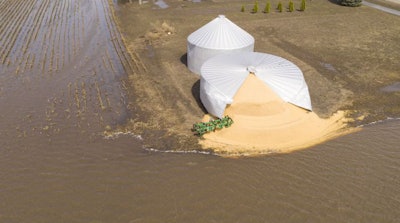
Animal feed mills and other grain-dependent businesses are beginning to feel the impact of last month’s flooding in the Midwest, although officials say it could be months before the full extent of the damages is known.
Mills, feed yards and even ethanol plants have begun to slow production in the wake of the record-setting floods, which cut a swath of destruction across six states. At present, the biggest impact to the feed industry is tied to transportation, according to Kristi Block, executive vice president of the Nebraska Grain and Feed Association. In Nebraska, which alongside Iowa bore the brunt of the disaster, some 20 percent of the state’s roads remain damaged or closed, Block said.
“In the initial days after the storm, flooding was a big issue,” said Louise Calderwood, director of regulatory affairs for the American Feed Industry Association, in a statement. “A couple weeks out, repair of transportation infrastructure is a major concern.”
As of the last count on March 25, nearly 300 miles of roads were still closed including Interstate 29 between Omaha and Iowa, Block said. Many roads in northeast Nebraska are still subject to temporary weight restrictions or lane reductions. Fuel prices have also surged 10-20 cents per gallon.
The transportation situation has “really strained the industry in finding product, which has led to cutting back operations,” Block said. She herself has been unable to visit flood-affected areas due to road closures.
The Nebraska Cattlemen’s Association estimates the increased transportation expenses and related losses have cost feedlots about $1 million per day. The association also estimates some $400 million in livestock losses and $440 million in lost crops.
But the full extent of the damage is still unknown, Block said, because insurance inspectors have similarly been unable to reach impacted areas. She anticipated that final tallies won’t be available until this fall. Impacts, however, could be dramatic: flood-affected grain and feed must be removed from the food supply, and U.S. Department of Agriculture figures suggest farmers had more grain in storage than is normal, Block said.











